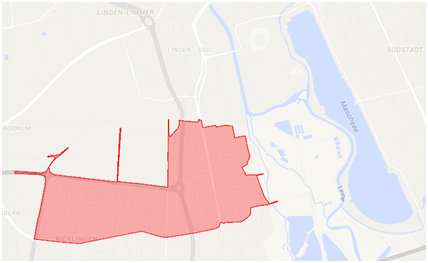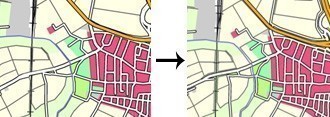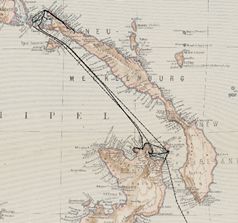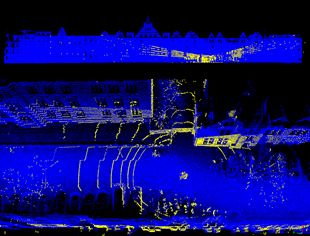Mobility
-
Prediction of behaviour and its storage in mapsIn the context of the RTG i.c.sens, the behavior of objects and phenomena in the environment will be studied in order to describe it and store it in maps.Led by: Sester, MonikaTeam:Year: 2025Funding: DFG Graduiertenkolleg i.c.sensDuration: 2022-2024
![]()
![]()
-
DiNaMo: Digitalisierung für nachhaltige MobilitätIn Deutschland ist der Verkehrssektor für knapp 20 Prozent der CO2-Emissionen sowie Lärm- und Feinstaubbelastungen verantwortlich, ohne dass ein Trend zur Reduktion sichtbar ist. Auch an Hochschulen spiegelt sich dieser Trend wider. An diesem Punkt setzt ein neues BMBF-Verbundsprojekt unter Koordination des Green Office der Leibniz Universität Hannover (LUH) an. DiNaMo hat das Ziel, nachhaltige Mobilität an Hochschulen digital zu unterstützen und zu fördern. Das BMBF fördert DiNaMo mit rund 1,5 Millionen Euro. Im Rahmen des Projekts werden Maßnahmen zur Förderung eines nachhaltigeren Mobilitätsverhaltens an den beteiligten Einrichtungen entwickelt, pilotiert und Erfolge bzw. Hemmnisse im Rahmen einer umfassenden Begleitforschung erfasst. Viele der in DiNaMo untersuchten Beispiele sind bereits in der Praxis etabliert, bergen aber unterschiedliche Herausforderungen, wodurch die Nutzung häufig eingeschränkt ist. An dieser Schnittstelle wird im Projekt angesetzt, um die Akzeptanz verschiedener digitaler Tools für eine nachhaltigere Mobilität zu untersuchen und deren Nutzung zu erhöhen. Beispielsweise wird eine App entwickelt, mit der Mitfahrgelegenheiten innerhalb der Hochschule organisiert werden. Eine breite Beteiligung von Student*innen und Mitarbeiter*innen als Beteiligte, Proband*innen und Initiator*innen stellt sicher, dass das Vorhaben dem gesamtinstitutionellen Ansatz folgt. Zudem können Mitarbeitende und Studierende der drei Hochschulen eigene Ideen für eine nachhaltigere Mobilität einbringen. So sollen etwa Workshops organisiert werden, um Visionen zu entwickeln, Ideen zu planen und Umsetzungsprojekte auf dem Campus zu fördern.Year: 2024Funding: BMBF
![]()
![]()
-
5GAPS - Anwendung im Bereich Urbane LogisitkDas Projekt 5GAPS (Access to Public Spaces) entwickelt ein alternatives 5G-mobilfunkgestütztes, zeitlich dynamisches Positionierungssystem auf Basis eines digitalen Zwillings des öffentlichen und halböffentlichen Raums in Form eines dreidimensionalen Rasters. Am ikg werden die Themen 1) Lokalisierung innerhalb und mit Hilfe der 3D-Struktur 2) Visualisierung und Interaktion mit der 3D-Struktur 3) Anwendung der 3D-Struktur für die urbane Logistik bearbeitet.Led by: Sester, Monika; Feuerhake, UdoTeam:Year: 2022Funding: Bundesministerium für Digitales und Verkehr, Förderkennzeichen: 45FGU121_E
![]()
![]()
-
Zukunftslabor MobilitätIm Rahmen des Zukunftslabors Mobilität arbeitet das ikg im Collaborative Research Field 4 am Thema der Mobilitätsdienste. Am CRF 4 sind WissenschaftlerInnen der Disziplinen Dienstleistungsmanagement ( Prof. David Woisetschläger, TU Braunschweig), Wirtschaftsinformatik (Prof. Jörg Müller, TU Clausthal) und Geoinformatik beteiligt. Ausgehend von den Potentialen der hochgradigen Vernetzung intelligenter Fahrzeugsysteme und Infrastrukturen sollen neue Dienstleistungen und Geschäftsmodelle für intelligente Fahrzeuge und (intermodale) Mobilitätslösungen entwickelt, untersucht und demonstriert werden. Im Fokus steht die Anwendung von Methoden für die Exploration von Anforderungen, die Entwicklung und Bewertung von Dienstleistungen für die nutzerspezifische Mobilitätsplanung, Untersuchungen zur Akzeptanz sowie Methoden zur Konzeption, Implementierung und Evaluation digitaler Geschäftsmodelle und hybrider Dienste.Led by: SesterTeam:Year: 2019Funding: MWK NiedersachsenDuration: 2019-2024
![]()
![]()
Big Data and Machine Learning
-
Object detection in airborne laser scanning (ALS) data using deep learningIn partnership with the Lower Saxony State Office for Preservation of Historic Monuments, we are developing a method for automatically detecting archaeological objects in airborne laser scanning data. The type of objects to be detected are mainly those of interest by archaeologists such as heaps, shafts, charcoal piles, pits, barrows, bomb craters, hollow ways, etc. They could be point, linear, or areal objects. To this end, we are using deep learning techniques; namely, convolutional neural networks (CNNs) to classify height images from the region of interest. A combination of multiple (in most cases 5) CNN classifiers are then used to detect and localize objects of interest in a digital terrain model acquired from the region of interest.Team:Year: 2018Funding: MWK Pro*Niedersachsen
![]()
![]()
-
3D object extraction of high-resolution 3D point cloudsNational Survey Departments acquire area-wide, controlled airborne laser scanning (ALS) datasets with different point densities, which are at least classified into ground and non-ground points. The Working Committee of the Surveying Authorities of the Laender of the Federal Republic of Germany (AdV) is discussing about an update cycle of 10 years for ALS point clouds. The national survey departments also acquire 3D point clouds from aerial images every 2-3 years with high overlapping ratios using a method called Dense Image Matching (DIM). Those DIM point clouds have a high point density, which is equal to the original aerial image resolution. In addition, those DIM point clouds also contain radiometric information from the aerial images, but only reconstruct the surface due to image correlation. This project is split into four distinctive topics.Led by: Sester, MonikaTeam:Year: 2017Funding: Forschungs- und Entwicklungsvorhaben zwischen den Landesvermessungsämtern Niedersachsen, Schleswig-Holstein und Mecklenburg-VorpommernDuration: seit 2017
![]()
![]()
-
Scene analysis - pattern recognition in person tracksThe project deals with the automatic recognition of conspicuous movement patterns from given trajectories as (x, y, t) sequences of objects. For this purpose, patterns are defined that indicate conspicuous behavior for which automatic extraction methods are to be researched. This includes, among others, the qualitative description of the recognition rates of patterns.Team:Year: 2017
![]()
![]()
-
Real Time Prediction of Pluvial Floods and Induced Water Contamination in Urban Areas (EVUS)This project aims at developing a fast forecast model for pluvial floods in the city of Hannover. The main goal of the subproject for ikg is to integrate new sensors for the flood prediction models.Team:Year: 2017Funding: BMBF Georisiken
![]()
![]()
Generalization
-
PUSH -- Automatic Cartographic Displacement Based on OptimizationThe software program PUSH allows the automatic displacement of geo-objects of all types, i.e. points, lines and polygons. The object characteristics which influence the displacement behaviour can be parametrized in a very flexible way: either object specific or object-class specific. The results allow for an automatic quality control. The program is able to generalize also large data sets.Team:Year: 2021
![]()
![]()
-
Controlling pedestrian motion using Augmented RealityControlling pedestrian motion pattern using augmented reality requires explainable visualizations to convince the user to change directions and speed of motion. Such AR visualizations should avoid cognitive overload and should provide motion guidance that are accurate representations of expected user actions to avoid conflicts / collisions.Led by: SesterTeam:Year: 2020Funding: DAAD - im Rahmen des GRK SocialCarsDuration: 2020-2023
![]()
![]()
Data Integration
-
VGI-LOC: Zukunftslabor Wasser - ZDINDas ikg ist Partner im Projekt Zukunftlabor Wasser, einer vom MWK geförderten Initiative zur Digitalsierung im Bereich Wasser.Led by: Sester, MonikaTeam:Year: 2022Funding: MWK NiedersachsenDuration: 2022-2025
![]()
![]()
3D Visualization
-
DiViAS - Digitalisierung, Visualisierung und Analyse von SammlungsgutDigitalisierung, Visualisierung und Analyse von Sammlungsgut (DiViAS) Der Forschungsverbund DiViAS bringt wissenschaftliche Methoden und Praktiken beim Digitalisieren, Erforschen und Repräsentieren von Sammlungsgut aus kolonialen Kontexten zusammen. Das Projekt verbindet systematisch die Expertise aus Museums-, Geschichts- und Kulturwissenschaften mit derjenigen aus Technik und Informatik – etwa in puncto Künstliche Intelligenz (KI), Datenanalyse, Geoinformatik und dreidimensionaler Messtechnik. Das Projekt wird aus dem Programm „zukunft.niedersachsen“ der VolkswagenStiftung gefördert. Am ikg werden Möglichkeiten der Visuellen Kommunikation von raum-zeitlichen Objekten und Phänomenen unter dem Gesichtspunkt der Unsicherheit untersucht.Led by: SesterTeam:Year: 2024Funding: MWK zukunft.niedersachsen
![]()
![]()
-
Controlling pedestrian motion using Augmented RealityControlling pedestrian motion pattern using augmented reality requires explainable visualizations to convince the user to change directions and speed of motion. Such AR visualizations should avoid cognitive overload and should provide motion guidance that are accurate representations of expected user actions to avoid conflicts / collisions.Led by: SesterTeam:Year: 2020Funding: DAAD - im Rahmen des GRK SocialCarsDuration: 2020-2023
![]()
![]()
Laser Scanning
-
5GAPS - Lokalisierung“Lokalisierung von mobilen Objekten in 3D-Rasterdaten” Das Projekt 5GAPS entwickelt ein alternatives 5G-mobilfunkgestütztes, hochgenaues und um Eigenschaften erweitertes dynamisches Positionierungssystem auf Basis eines digitalen Zwillings des (halb)öffentlichen Raums in Form eines 3-D-Rasters und führt erste Proofs-of-Concept durch. Das Projekt wird mit verschiedenen Partnern aus Wissenschaft und Wirtschaft bearbeitet. Am Institut für Kartographie und Geoinformatik sollen dabei Aufgaben im Bereich der Erfassung, Verarbeitung und Visualisierung der hochdimensionalen Daten durchgeführt werden.Led by: Sester, MonikaTeam:Year: 2022Funding: Bundesministerium für Digitales und Verkehr, Förderkennzeichen: 45FGU121_EDuration: 2022-2024
![]()
![]()
-
Object detection in airborne laser scanning (ALS) data using deep learningIn partnership with the Lower Saxony State Office for Preservation of Historic Monuments, we are developing a method for automatically detecting archaeological objects in airborne laser scanning data. The type of objects to be detected are mainly those of interest by archaeologists such as heaps, shafts, charcoal piles, pits, barrows, bomb craters, hollow ways, etc. They could be point, linear, or areal objects. To this end, we are using deep learning techniques; namely, convolutional neural networks (CNNs) to classify height images from the region of interest. A combination of multiple (in most cases 5) CNN classifiers are then used to detect and localize objects of interest in a digital terrain model acquired from the region of interest.Team:Year: 2018Funding: MWK Pro*Niedersachsen
![]()
![]()
-
3D object extraction of high-resolution 3D point cloudsNational Survey Departments acquire area-wide, controlled airborne laser scanning (ALS) datasets with different point densities, which are at least classified into ground and non-ground points. The Working Committee of the Surveying Authorities of the Laender of the Federal Republic of Germany (AdV) is discussing about an update cycle of 10 years for ALS point clouds. The national survey departments also acquire 3D point clouds from aerial images every 2-3 years with high overlapping ratios using a method called Dense Image Matching (DIM). Those DIM point clouds have a high point density, which is equal to the original aerial image resolution. In addition, those DIM point clouds also contain radiometric information from the aerial images, but only reconstruct the surface due to image correlation. This project is split into four distinctive topics.Led by: Sester, MonikaTeam:Year: 2017Funding: Forschungs- und Entwicklungsvorhaben zwischen den Landesvermessungsämtern Niedersachsen, Schleswig-Holstein und Mecklenburg-VorpommernDuration: seit 2017
![]()
![]()























